Hydrology and Nutrient Dynamics in Managed Restored Wetlands of California’s Central Valley, USA
Abstract
1. Introduction
2. Materials and Methods
2.1. Study Area and Sites
2.2. Restored Wetland Hydrology
3. Results
3.1. Historic Versus Current Wetland Hydrology
3.2. Restored Wetland Hydrology and Management
3.3. Water Depth Assessment
3.4. Water Quality
3.5. Trend Analysis
4. Discussion
5. Conclusions
- This was the first study examining nutrient dynamics in a broad range of restored managed wetlands over drought and flooding periods in California.
- The study highlighted the complex nature of hydrological and nutrient dynamics in managed wetlands in California’s Central Valley but indicated some potential for lowering nutrient loads.
- Hydrology has changed substantially in the last 170 years with shifting emphasis on artificial or manual water application driven by site-specific specific management objectives.
- Differences in source water quality may be the result of agricultural runoff from adjacent croplands flowing into the shared network of irrigation and drainage canals. Implementation of vegetation buffers at inflows should be explored as ways to limit inflowing nutrients.
- Wetlands in this region experience frequent water shortages due to drought as well as legislative and management decisions limiting water deliveries when snowpack and reservoir volumes are low.
- If ambient temperatures rise, coupled with reduced water availability due to recurring drought, we may expect evapotranspiration to increase nutrient concentrations in serially connected wetlands where water is held for some period of time.
- Despite increasing concentrations in some wetlands, overall reduction in ammonium and nitrate loads to natural waterways and canals may have more long-term biological benefits for species sensitive to water chemistry such as fish and amphibians.
- Opportunistic wetland restoration opportunities and collaborations with private landowners may still yield multiple benefits if they have adequate access to water supplies and technical guidance for hydrological management.
Author Contributions
Funding
Data Availability Statement
Acknowledgments
Conflicts of Interest
References
- Harter, T.; Lund, J.R.; Darby, J.; Fogg, G.; Howitt, R.; Jessoe, K.; Pettygrove, S.G.; Quinn, J.F.; Viers, J.H.; Boyle, D.B.; et al. Addressing Nitrate in California’s Drinking Water with a Focus on Tulare Lake Basin and Salinas Valley Groundwater. Report for the State Water Resources Control Board Report to the Legislature; Center for Watershed Sciences, University of California: Davis, CA, USA, 2012. [Google Scholar]
- Jassby, A.D. Phytoplankton regulation in a eutrophic tidal river (San Joaquin River, California). In San Francisco Estuary and Watershed Science; John Muir Institute of the Environment, UC: Davis, CA, USA, 2005. [Google Scholar]
- Matiasek, S.J.; Pellerin, B.A.; Spencer, R.G.M.; Bergamaschi, B.A.; Hernes, P.J. Irrigation as a fuel pump to freshwater ecosystems. Biogeochemistry 2017, 136, 71–90. [Google Scholar] [CrossRef]
- Aldous, A.; McCormick, P.; Ferguson, C.; Graham, S.; Craft, C. Hydrologic regime controls soil phosphorus fluxes in restoration and undisturbed wetlands. Restor. Ecol. 2005, 13, 341–347. [Google Scholar] [CrossRef]
- California Natural Resources Agency. State of the State’s Wetlands: 10 Years of Challenges and Progress; Natural Resources Agency: Sacramento, CA, USA, 2010.
- California State Water Resources Control Board. Water Rights. 2022. Available online: https://www.waterboards.ca.gov/waterrights/board_info/faqs.html (accessed on 25 July 2022).
- Carpenter, K.D.; Snyder, D.T.; Duff, J.D.; Triska, F.J.; Lee, K.K.; Avanzino, R.J.; Sobieszczyk., S. Hydrologic and Water-Quality Conditions During Restoration of the Wood River Wetland Upper Klamath River Basin, Oregon, 2003–2005 Scientific Investigations Report 2009-5004; U.S. Geological Survey: Reston, VA, USA, 2009.
- Carpenter, S.R.; Caraco, N.F.; Correll, D.L.; Howarth, R.W.; Sharpley, A.N.; Smith, V.H. Nonpoint pollution of surface waters with phosphorus and nitrogen. Ecol. Appl. 1998, 8, 559–568. [Google Scholar] [CrossRef]
- Central Valley Joint Venture (CVJV). Central Valley Joint Venture Implementation Plan-Conserving Bird Habitat; U.S. Fish and Wildlife Service: Sacramento, CA, USA, 2020.
- California Department of Water Resources (CDWR). 2015. Available online: http://www.water.ca.gov/ (accessed on 5 August 2015).
- Cronk, J.K.; Fennessy, S. Wetland Plants: Biology and Ecology; CRC Press: Boca Raton, FL, USA, 2001. [Google Scholar]
- Dahl, T.E. Wetland Losses in the United States 1780’s to 1980’s; U.S. Fish and Wildlife Service: Washington, DC, USA, 1990.
- Day, W., Jr.; Arancibia, A.Y.; Mitsch, W.J.; Lara-Dominguez, A.L.; Day, J.N.; Ko, J.Y.; Lane, R.; Lindsey, J.; Lomeli, D.Z. Using ecotechnology to address water quality and wetland habitat loss problems in the Mississippi basin: A hierarchical approach. Biotechnol. Adv. 2003, 22, 135–159. [Google Scholar] [CrossRef]
- Duffy, W.G.; Kahara, S.N.; Records, R.M. (Eds.) Conservation Effects Assessment Project—Wetlands Assessment in California’s Central Valley and Upper Klamath River Basin; U.S. Geological Survey Open-File Report 2011–1290; U.S. Geological Survey: Reston, VA, USA, 2011.
- Farr, T.G.; Jones, C.; Liu, Z. Progress Report: Subsidence in the Central Valley, California; NASA’s Jet Propulsion Laboratory: Pasadena, CA, USA, 2015. [Google Scholar]
- Faunt, C.C.; Sneed, M.; Traum, J.; Brandt, J.T. Water availability and land subsidence in the Central Valley, California, USA. Hydrol. J. 2015, 24, 675–684. [Google Scholar]
- Fisher, J.; Acreman, M.C. Wetland nutrient removal: A review of the evidence. Hydrol. Earth Syst. Sc. 2004, 8, 673–685. [Google Scholar] [CrossRef]
- Fredrickson, L.H.; Taylor, T.S. Management of Seasonally Flooded Impoundments for Wildlife; U.S. Fish and Wildlife Service Resource Publication 148: Washington DC, USA, 1982.
- Garone, P. The Fall and Rise of Wetlands of California’s Great Central Valley; University of California Press: Berkeley, CA, USA, 2011. [Google Scholar]
- Goslee, S.C.; Brooks, R.P.; Cole, C.A. Plants as indicators of wetland water source. Plant Ecol. 1997, 131, 199–206. [Google Scholar] [CrossRef]
- Heidel, K.; Roy, S.; Creager, C.; Chung, C.; Grieb, T.; Region IX Central Valley Drinking Water Policy Working Group. Nutrients in The Central Valley and Sacramento–San Joaquin Delta; U.S. Environmental Protection Agency: Washington, DC, USA, 2006.
- Johannesson, K. Phosphorus Retention in a Constructed Wetland—The Role of Sediment Accretion. Ph.D. Thesis, Avdelning Institution, Gothenburg, Sweden, 2008. [Google Scholar]
- Kadlec, R.H.; Knight, R.K. Treatment Wetlands; Lewis Publisher: Boca Raton, FL, USA, 1996. [Google Scholar]
- Kahara, S.N.; Duffy, W.G.; DiGaudio, R.; Records, R. Climate, management and habitat associations of avian fauna in restored wetlands of California’s Central Valley, USA. Diversity 2012, 4, 396–418. [Google Scholar] [CrossRef]
- Knobeloch, L.; Salna, B.; Hogan, A.; Postle, J.; Anderson, H. Blue babies and nitrate-contaminated well water. Environ. Health Perspect. 2000, 108, 675–678. [Google Scholar] [CrossRef]
- Kim, S.; Jeong, J.; Kahara, S.N.; Kiniry, J.R. APEX simulation: Water quality of Sacramento Valley wetlands impacted by waterfowl droppings. J Soil Water Conserv. 2020, 75, 713–726. [Google Scholar] [CrossRef]
- Liu, Q.; Liu, J.; Liu, H.; Liang, L.; Cai, Y.; Wang, X.; Li, C. Vegetation dynamics under water-level fluctuations: Implications for wetland restoration. J. Hydrol. 2020, 581, 124418. [Google Scholar] [CrossRef]
- Madani, K.; Rowan, D.; Lund, J. The Next Step in Central Valley Flood Management: Connecting Costs and Benefits. Paper 17; Southern Illinois University Carbondale: Chicago, IL, USA, 2007; Available online: http://opensiuc.lib.siu.edu/ucowrconfs_2007/17 (accessed on 25 July 2022).
- Mitsch, W.J.; Gosselink, J.G. Wetlands, 5th ed.; John Wiley & Sons, Inc.: New York, NY, USA, 2015. [Google Scholar]
- Keiser, D.A.; Shapiro, J.S. Consequences of the Clean Water Act and the Demand for Water Quality. Q. J. Econ. 2019, 134, 349–396. [Google Scholar] [CrossRef]
- Hansen, L.; Hellerstein, D.; Ribaudo, M.; Williamson, J.; Nulph, D.; Loesch, C.; Crumpton, W. Targeting Investments to Cost Effectively Restore and Protect Wetland Ecosystems: Some Economic Insights; Economic Research Service ERR-183: Washington, DC, USA, 2015.
- Tomscha, S.A.; Bentley, S.; Platzer, E.; Jackson, B.; de Roiste, M.; Hartley, S.; Norton, K.; Deslippe, J.R. Multiple methods confirm wetland restoration improves ecosystem services. Ecosyst. People 2021, 17, 25–40. [Google Scholar] [CrossRef]
- Vymazal, J. Removal of nutrients in various types of constructed wetlands. Sci. Total Environ. 2007, 380, 48–65. [Google Scholar] [CrossRef] [PubMed]
- Shi, H.; García-Reyes, M.; Jacox, M.G.; Rykaczewski, R.R.; Black, B.A.; Bograd, S.J.; Sydeman, W.J. Co-occurrence of California drought and Northeast Pacific marine heatwaves under climate change. Geophys. Res. Lett. 2021, 48, e2021GL092765. [Google Scholar] [CrossRef]
- Spieles, D.J.; Mitsch, W.J. The effects of season and hydrologic and chemical loading on nitrate retention in constructed wetlands: A comparison of low and high nutrient riverine systems. Ecol. Eng. 2000, 14, 77–91. [Google Scholar] [CrossRef]
- Niswander, S.F.; Mitsch, W.J. Functional analysis of a two-year-old created in-stream wetland: Hydrology, phosphorus retention, and vegetation survival and growth. Wetlands 1995, 15, 212–225. [Google Scholar] [CrossRef]
- Vymazal, J. Plants used in constructed wetlands with horizontal subsurface flow: A review. Hydrobiologia 2011, 674, 133–156. [Google Scholar] [CrossRef]
- O’geen, A.T.; Budd, R.; Gan, J.; Maynard, J.J.; Parikh, S.J.; Dahlgren, R.A. Mitigating nonpoint source pollution in agriculture with constructed and restored wetlands. Adv. Agron. 2010, 108, 1–76. [Google Scholar]
- Madurapperuma, B.D.; Amarasinghe, M.D.; Oduor, P.G. Salient ecological functions of a tropical freshwater wetland. Lake Reserv. Manag. 2013, 18, 45–51. [Google Scholar] [CrossRef]
- Reddy, K.R.; Kadlec, R.H.; Flaig, E.; Gale, P.M. Phosphorus retention in streams and wetlands: A review. Crit. Rev. Environ. Sci. Technol. 1999, 29, 83–146. [Google Scholar] [CrossRef]
- Shanafield, M.; Rigosi, A.; Liu, Y.; Brookes, J. The interaction of flow regimes and nutrient fluxes on the water quality and ecosystem health of a clear, freshwater wetland. Ecol. Soc. 2020, 25, 6. [Google Scholar] [CrossRef]
- Rouse, J.D.; Bishop, C.A.; Struger, J. Nitrogen pollution: An assessment of its threat to amphibian survival. Environ. Health Perspect. 1999, 107, 799–803. [Google Scholar] [CrossRef] [PubMed]
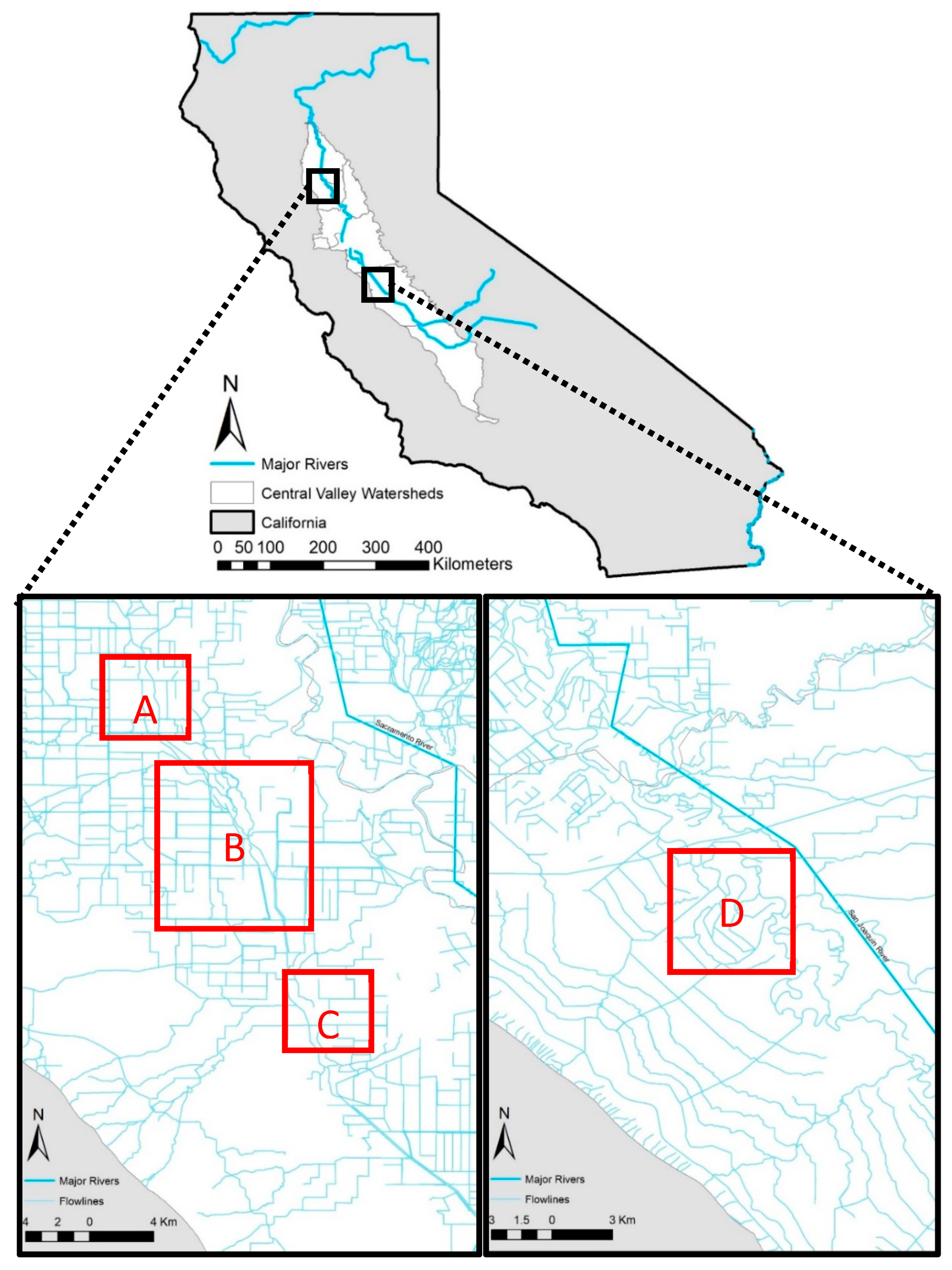
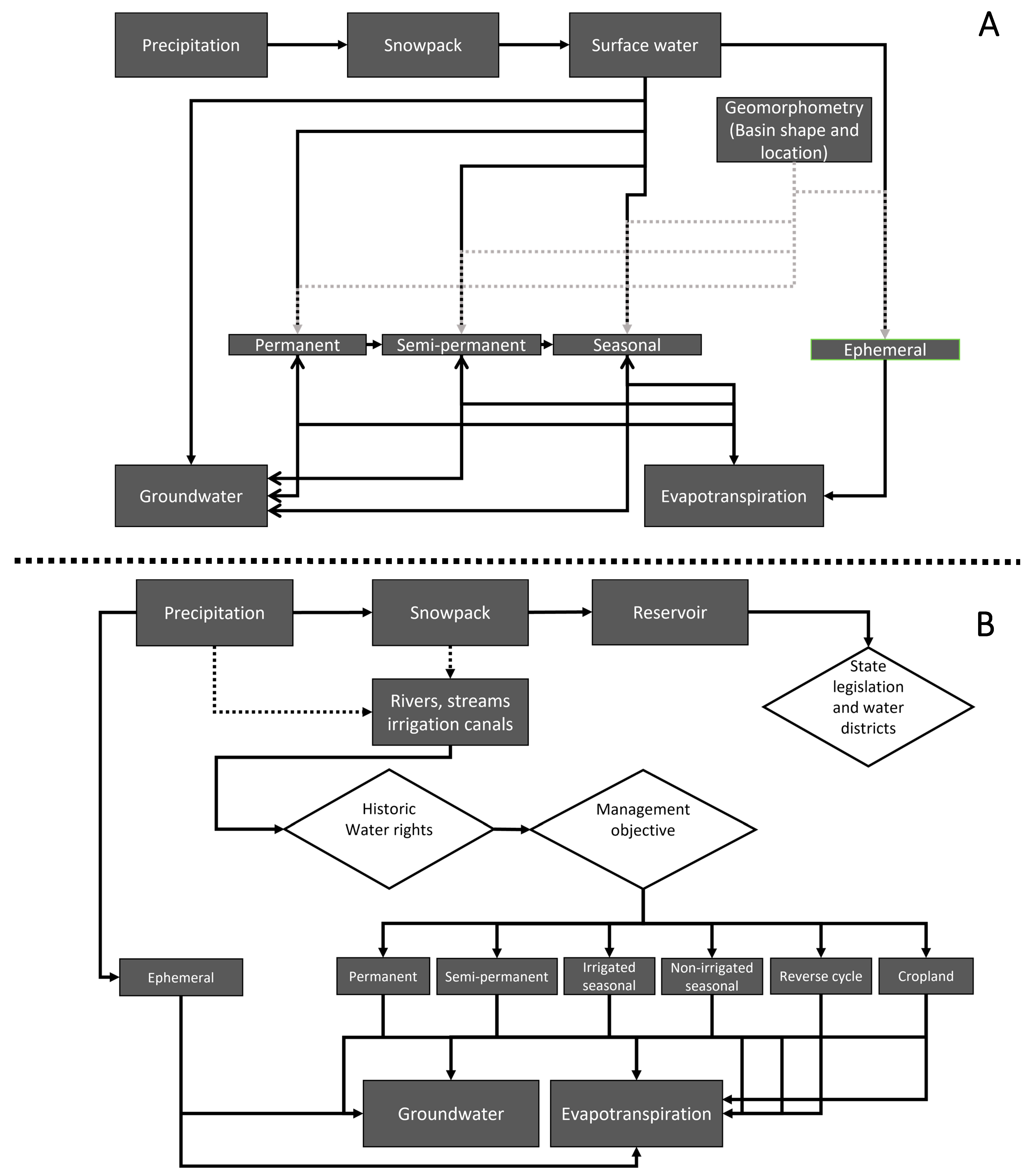
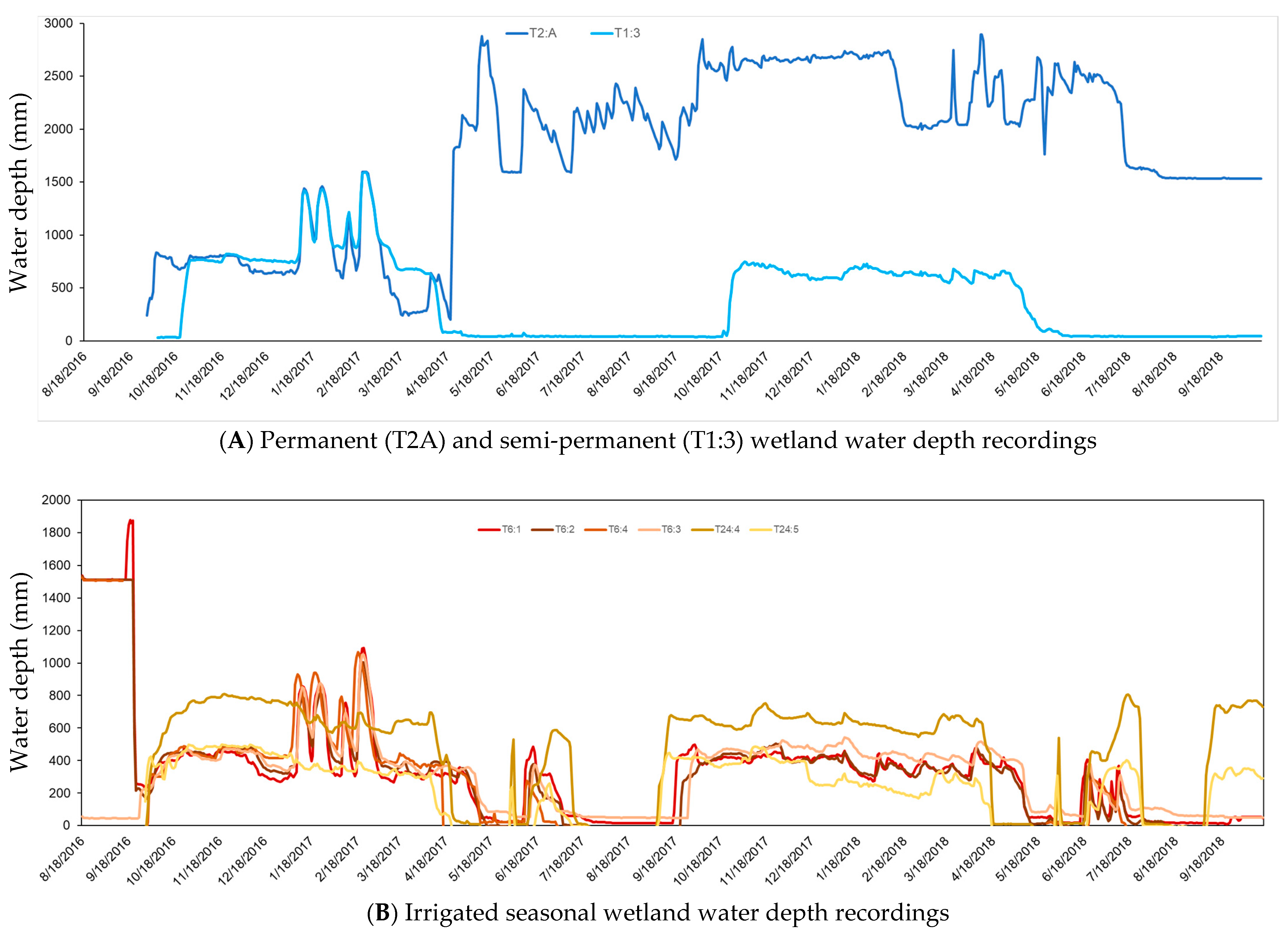
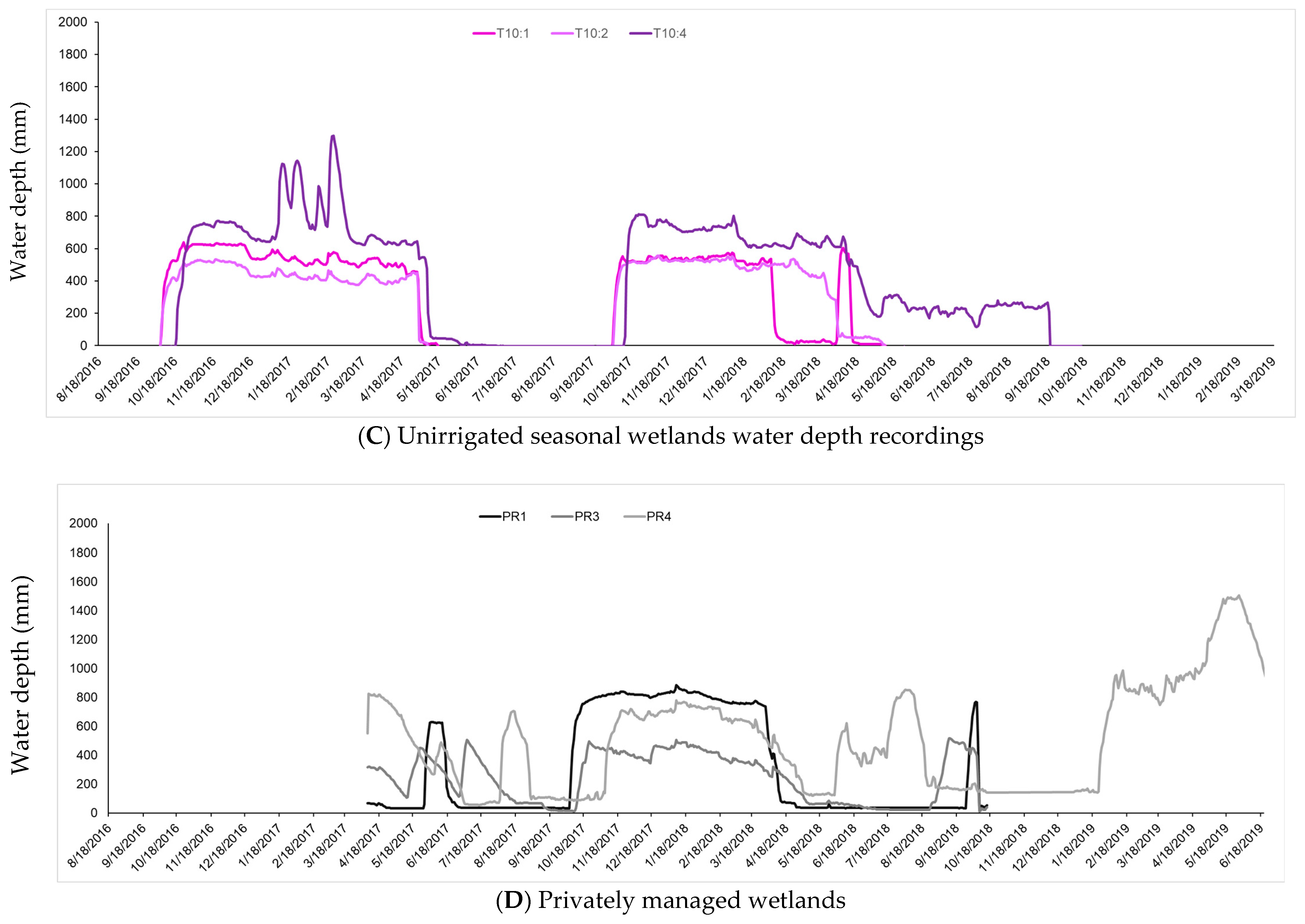
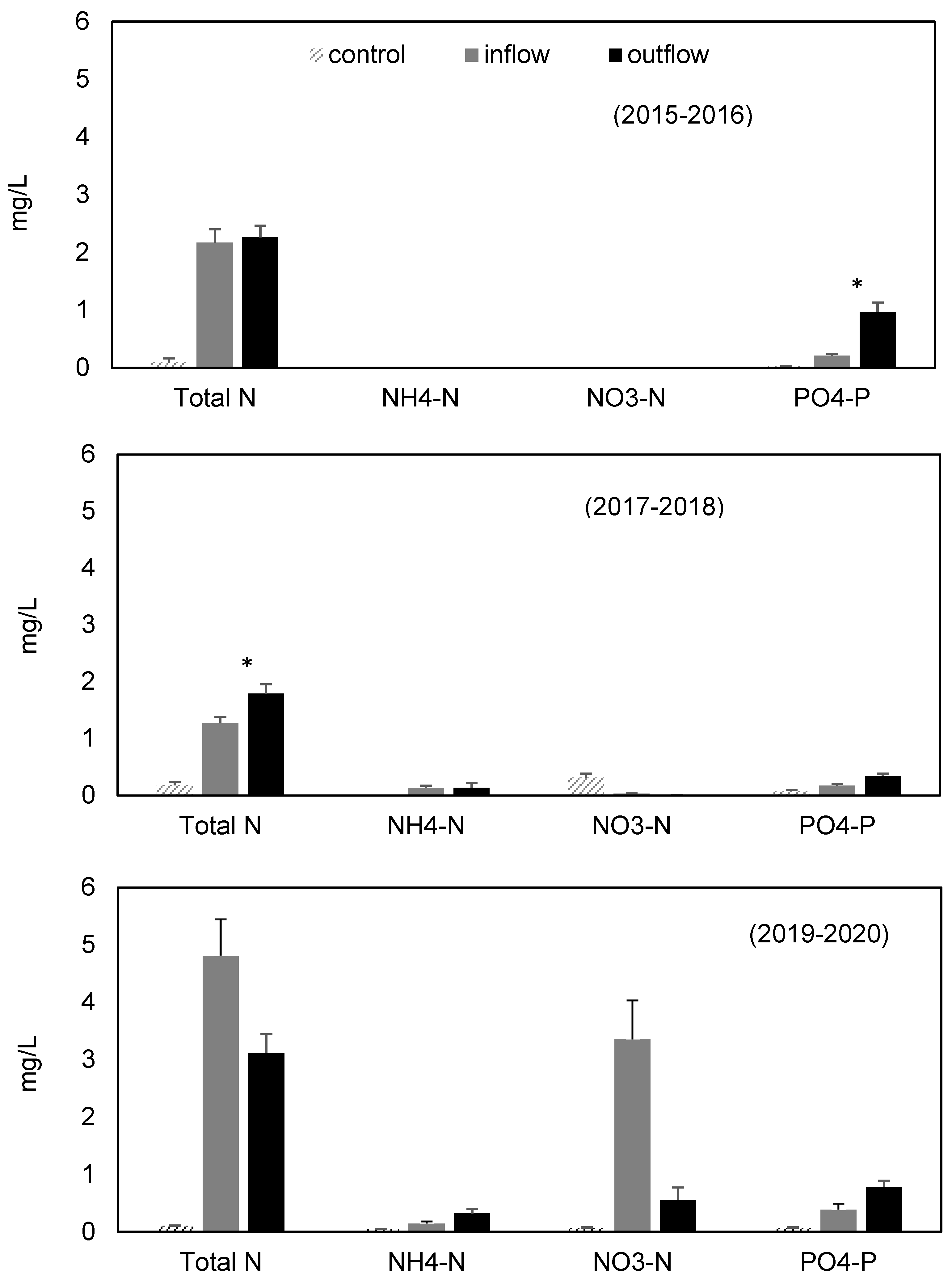

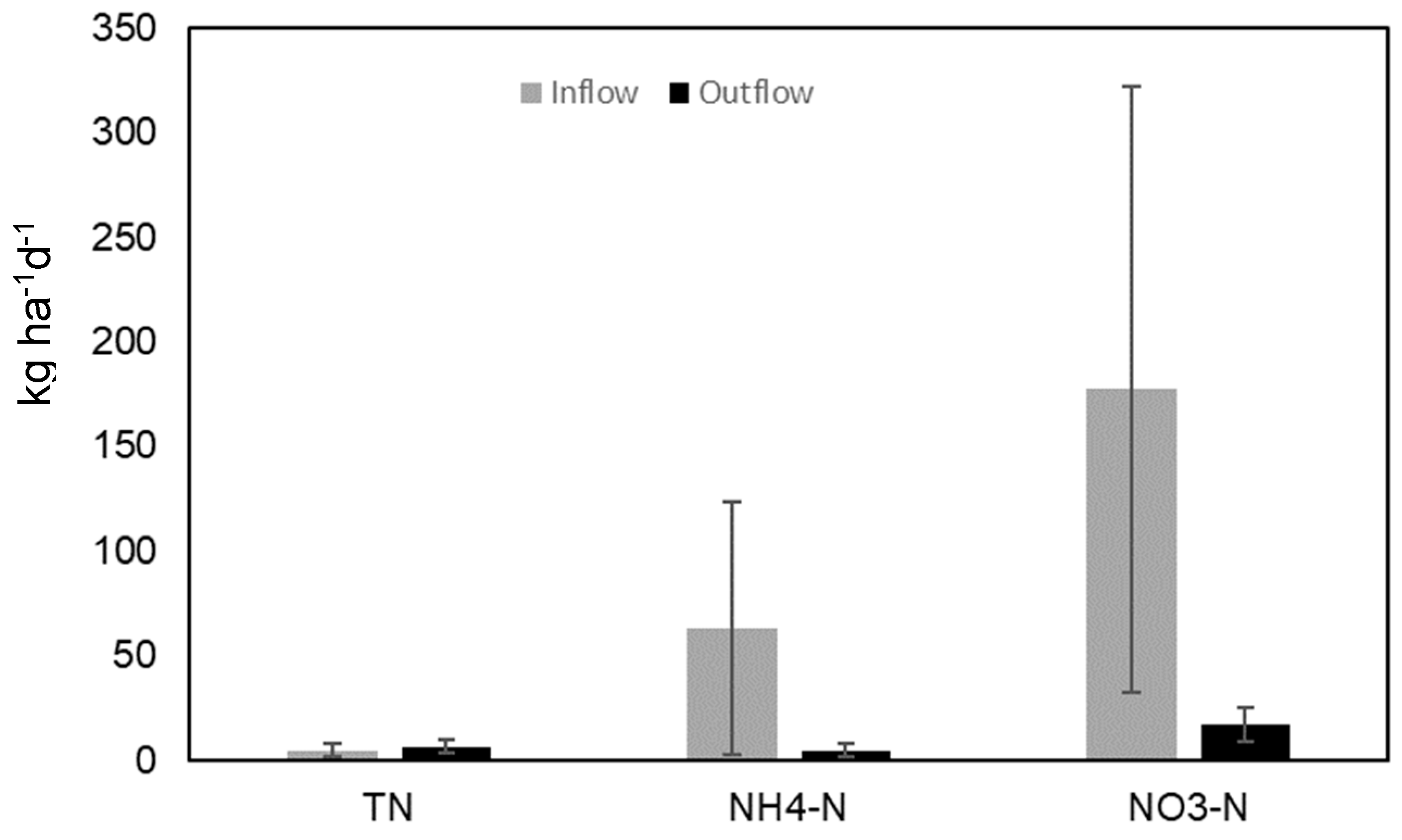


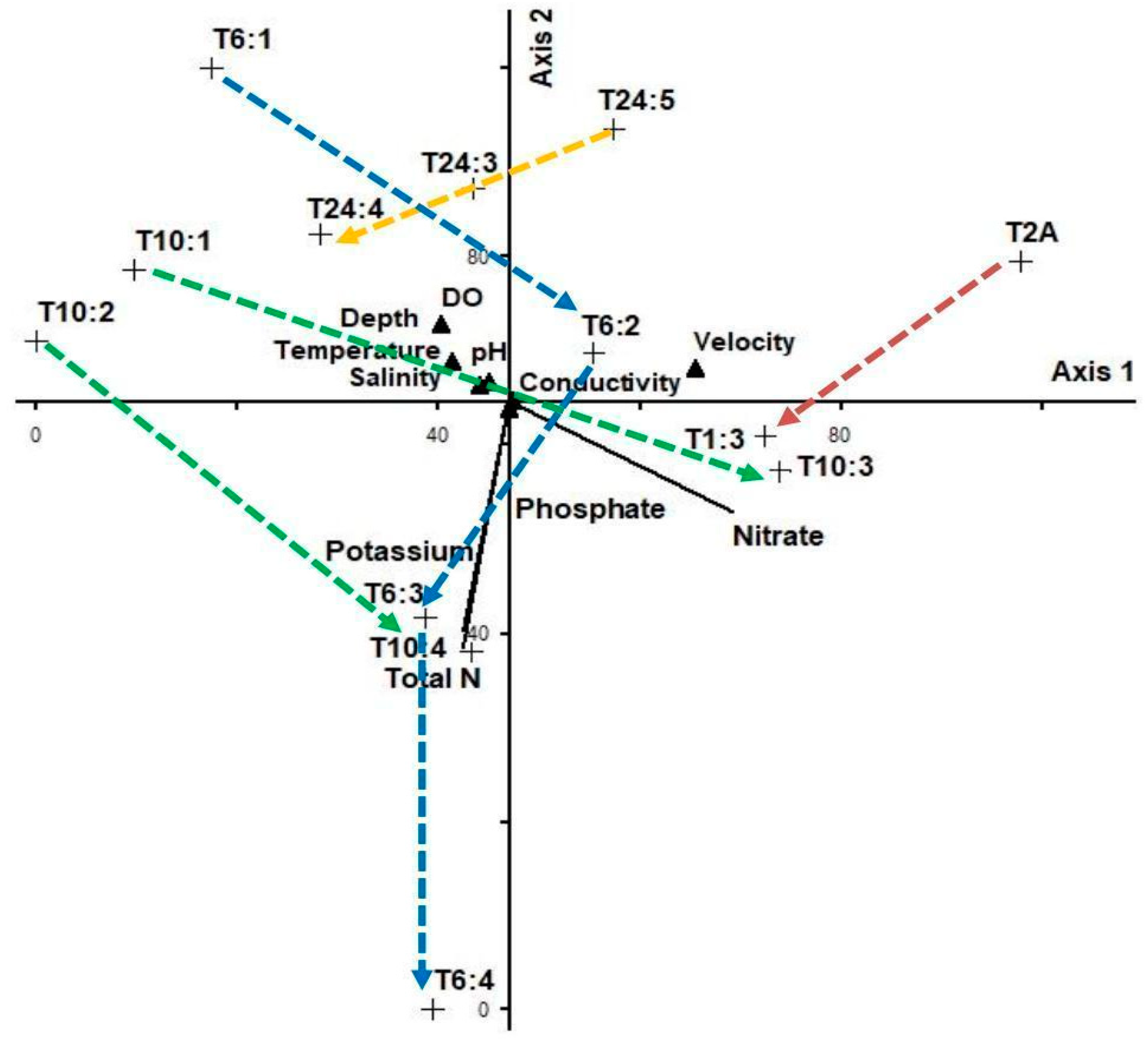
| Site | Management | Continuous Water Depth Measurements (Days) | Average Logged Depth (mm) | Proportion of Recordings <120 mm (%) |
|---|---|---|---|---|
| T2A | Permanent | 747 | 1791.8 | 0% |
| T1:3 | Semi-permanent | 735 | 1749.8 | 40% |
| T6:1 | Irrigated seasonal | 789 | 330.8 | 0.3% |
| T6:2 | Irrigated seasonal | 782 | 310.0 | 25% |
| T6:3 | Irrigated seasonal | 778 | 793.8 | 17% |
| T6:4 | Irrigated seasonal | 482 | 312.7 | 32% |
| T10:1 | Unirrigated seasonal | 639 | 277.5 | 35% |
| T10:2 | Unirrigated seasonal | 651 | 268.5 | 34% |
| T10:3 | Unirrigated seasonal | 602 | 313.6 | 40% |
| T10:4 | Unirrigated seasonal | 740 | 423.0 | 23% |
| T24:3 | Irrigated seasonal | n/a | n/a | n/a |
| T24:4 | Irrigated seasonal | 739 | 443.48 | 22% |
| T24:5 | Irrigated seasonal | 749 | 221.04 | 29% |
| PR2 | Unirrigated seasonal | 107 | 15.22 | – |
| PR1 | Unirrigated seasonal | 557 | 312.23 | 0% |
| PR4 | Unirrigated seasonal | 904 | 465.76 | 0% |
| PR3 | Unirrigated seasonal | 577 | 334.97 | 0% |
| SJ14 (Upper White Lake) | Reverse cycle | 108 | 601.1 | 0% |
| SJ15 (Lower White Lake) | Reverse cycle | n/a | n/a | n/a |
| SJ16 (White Lake) | Permanent | 108 | 952.56 | 0% |
| SJ19 (North Vierra) | Seasonal | 108 | 187.35 | 0% |
| Mean Daily Yield (kg ha−1 d−1) | ||||||||
|---|---|---|---|---|---|---|---|---|
| TN | NH4-N | NO3-N | PO4-P | |||||
| Inflow | Outflow | Inflow | Outflow | Inflow | Outflow | Inflow | Outflow | |
| Sacramento | ||||||||
| Permanent | 89.4 | 12.2 | 1394.1 | 27.9 | 2448.4 | 0.7 | 37.2 | 10.1 |
| Seasonal Irrigated | 1.6 | 7.4 | 2.8 | 3.8 | 32.3 | 21.0 | 0.2 | 1.1 |
| Seasonal Unirrigated | 1.4 | 2.6 | 4.2 | 0.2 | 57.0 | 3.4 | 0.2 | 0.5 |
| Semi-permanent | 0.1 | 9.4 | 0.0 | 0.1 | 0.7 | 2.1 | 0.1 | 6.4 |
| San Joaquin | ||||||||
| Permanent | 3.4 | 5.7 | 1.0 | 2.5 | 53.5 | 60.6 | 0.1 | 0.0 |
Publisher’s Note: MDPI stays neutral with regard to jurisdictional claims in published maps and institutional affiliations. |
© 2022 by the authors. Licensee MDPI, Basel, Switzerland. This article is an open access article distributed under the terms and conditions of the Creative Commons Attribution (CC BY) license (https://creativecommons.org/licenses/by/4.0/).
Share and Cite
Kahara, S.N.; Madurapperuma, B.D.; Hernandez, B.K.; Scaroni, L.; Hopson, E. Hydrology and Nutrient Dynamics in Managed Restored Wetlands of California’s Central Valley, USA. Water 2022, 14, 3574. https://doi.org/10.3390/w14213574
Kahara SN, Madurapperuma BD, Hernandez BK, Scaroni L, Hopson E. Hydrology and Nutrient Dynamics in Managed Restored Wetlands of California’s Central Valley, USA. Water. 2022; 14(21):3574. https://doi.org/10.3390/w14213574
Chicago/Turabian StyleKahara, Sharon N., Buddhika D. Madurapperuma, Breana K. Hernandez, Luke Scaroni, and Eric Hopson. 2022. "Hydrology and Nutrient Dynamics in Managed Restored Wetlands of California’s Central Valley, USA" Water 14, no. 21: 3574. https://doi.org/10.3390/w14213574
APA StyleKahara, S. N., Madurapperuma, B. D., Hernandez, B. K., Scaroni, L., & Hopson, E. (2022). Hydrology and Nutrient Dynamics in Managed Restored Wetlands of California’s Central Valley, USA. Water, 14(21), 3574. https://doi.org/10.3390/w14213574






